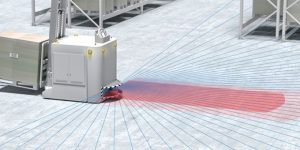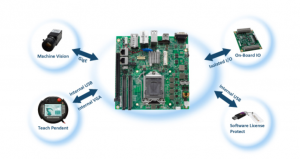What is an AGVs system

Automated guided vehicles (AGVs) system is a transport system in which primary tasks are moving and transporting items in production, warehouse, and distribution centers without manual intervention or permanent conveying systems.
An AGVs system includes:
Navigation and safety are interconnected functions. By “navigation”, it means how we reach the destination. By “safety”, it means at the same time, we are constantly paying attention to not collide to other subjects (other AGV, employees or objects, etc.)
Even though these two functions closely relate, they still are performed in quite different ways with different components and various equipment.
Let’s dive deep into each function to see how they work

Navigation refers to measures:
-
where the vehicle is located
-
where the vehicle would proceed if nothing were undertaken to change its course
-
what needs to be done in order to safely arrive at a desired destination, and if needed, along a prescribed route.
Technologies for AGVs navigation:
The Physical Guideline
-
The actively inductive guidance track, in which a current-bearing conductor is set into the floor
-
The passively inductive guidance track, in which a 5–10 cm wide metal strip is affixed to the floor.
-
The optical guidance track, in which a colored strip with a color that clearly contrasts to the floor is either painted on or taped down with a strip of material.
In complex layouts, the free approach, i.e., with a virtual guidance track, is used today
Anchoring Points in the Floor
AGVs will follow the anchoring points in the floor to reach their drop-off area. These anchor points can be purely passive permanent magnets or quasi-active transponders and they can be laid out in a grid or as a series of points
They can be laid out in a grid or as a series of points. A grid covering the entire surface area offers greater layout flexibility, while a series of points in principle requires fewer floor markers.
A key factor is the quality of the dead reckoning navigation, which can be improved by using a gyroscopic compass
Laser navigation
Laser navigation is the brightest name of free navigation (which route is realized virtually but not physically)
Laser scanner used to determine the position based on reflectors (artificial landmarks) as well as surrounding contours (natural landmarks)
The GPS
Radio-based methods are the most prominent, in which vehicles take their own bearings using running time to a satellite (GPS) or stationary, coded radar reflectors
GPS is not suitable for built-up surroundings, such as between buildings or in parts of large, open halls. In these locations, a so-called LPR (local positioning radar), an “indoor GPS” can be installed and used
2. Safety
Key technical safety features:
-
As with every machine, the AGV has an emergency stop switch, which has to be easily recognizable to everyone and accessible.
-
In order to allow people to be aware of the AGV in operation, the vehicles generally have a combination of optical (rotating warning lights) and acoustic warning signals.
-
Mechanical, independently operating brakes ensure proper stopping. The brakes must be designed so that they can stop the AGV even with a maximum payload and at maximum incline of the drive path (slope).
-
The brakes must be designed so that they can stop the AGV even with a maximum payload and also at maximum incline of the drive path (slope). The brakes must be designed so that they can stop the AGV even with a maximum payload and also at maximum incline of the drive path (slope).
-
Kick plates and special safety equipment for load handling provide for safe operations.
-
The personnel protection system is essential Mechanical systems react to contact and are designed, e.g., as plastic bales or soft foam bumpers. Contact-free sensors scan the endangered areas ahead of the vehicle using laser, radar, infrared or ultrasound, or a combination of several technologies.
In summary, the safety system works to ensure that no collision happen in the operation shift of an AGV
II. The guidance control system

To put it simply, this system is the brain of AGVs system as it includes the following functions:
– integrates AGVs into its surroundings
– offers users various services and receives transport orders
– provides corresponding function blocks to fulfill tasks
This software is so heavy in terms of technical sophistication so I do not want to spread out here incase readers might confuse
But the main concept of the guidance control system is it will draw the map for robots (AGVs) to follow and find most effective way to reach destinations
III. The vehicle guidance control system
 Pic1: example of a typical robot control system
Pic1: example of a typical robot control system
While the guidance control system is in charge of everything, namely from fulfilling tasks (processing transport orders), vehicle guidance control coordinates all the actions of the AGV. This makes vehicle guidance control one of the key components in an AGVS, especially since it consists of both hardware and software.
Functional modules of an AGVs control system include:
-
Manager/ communication (communicate to the guidance control system – upper management level & to robots)
-
Driving
-
Load picking (reference to docking)
-
Power management (charging)
-
Monitoring/ safety interface
For quicker AGVs or automation systems solution, contact us directly through:
Hotline: (+84) 984 695 398
Email: gluexpert@prostech.ph






